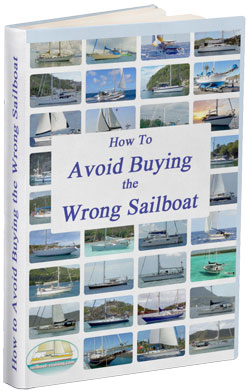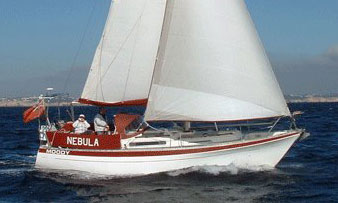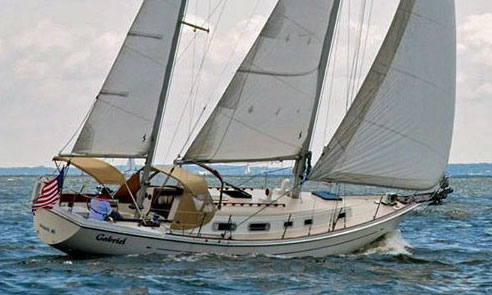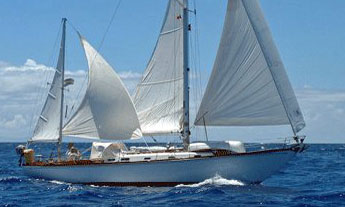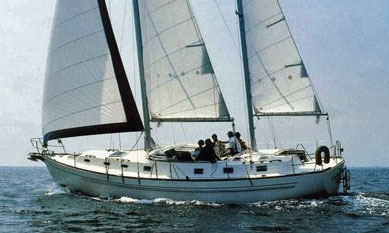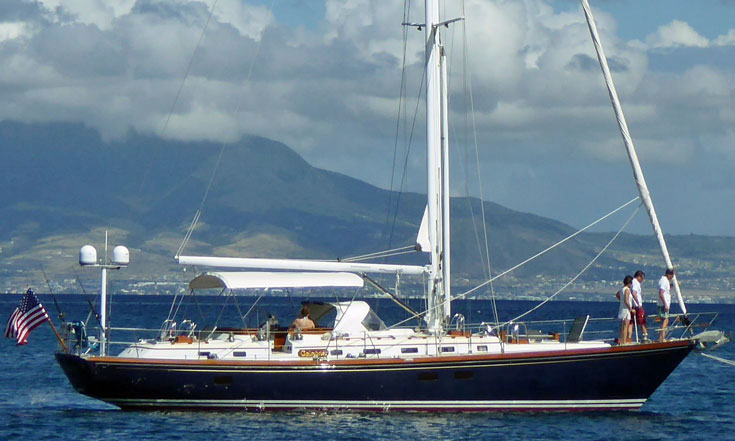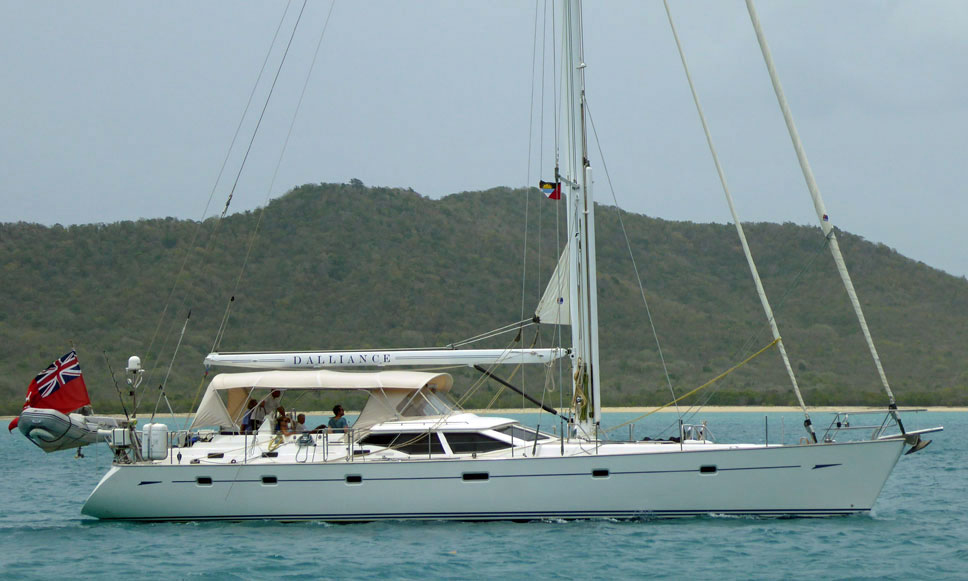- Home
- Cruising Yachts 40' to 45'
- Catalina Morgan 43
The Catalina Morgan 43 Sailboat
Specs & Key Performance Indicators
The Catalina Morgan 43 sailboat was designed by Nelson and Marek and manufactured by Catalina Yachts in the United States throughout the years 1985 to at least 1987.
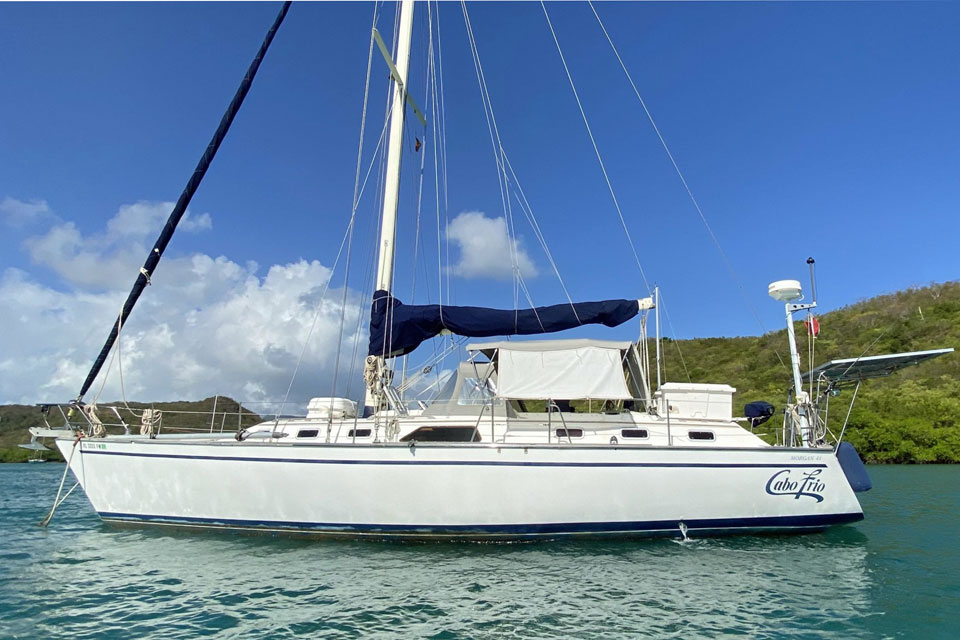 Catalina Morgan 43
Catalina Morgan 43Published Specification for the Catalina Morgan 43
Keel & Rudder Configuration: Fin with rudder on skeg
Hull Material: Fibreglass (FG)
Length Overall*: 43'0" / 13.11 m
Waterline Length*: 35'4" / 10.77 m
Beam*: 13'6" / 4.11 m
Draft*: 6'0" / 1.83 m
Rig Type: Masthead Sloop
Displacement*: 23,500.00 lb / 10,659 kg
Ballast*: 8,200.00 lb / 3,719 kg
Sail Area (main plus 100% foretriangle)*: 797 ft² / 74 m²
Water Tank Capacity: 200 US Gallons / 757 Litres
Fuel Tank Capacity: 60 US Gallons / 227.12 Litres
Hull Speed: 7.96 kn
Designer: Nelson and Marek
Builder: Catalina Yachts
Year First Built: 1985
Year Last Built: Production for the Catalina Morgan 43 appears to have continued at least until 1987. The exact end year is not explicitly stated in the readily available sources, but Catalina acquired Morgan Yachts in 1984, and the Morgan 381, the first new Morgan design after the acquisition, was introduced in 1993, suggesting the 43's production may have ceased around that time or earlier, making way for newer models.
Number Built: The exact number of Catalina Morgan 43s built is not explicitly stated in the provided sources.
* Used to derive the design ratios referred to later in this article - here's how they're calculated...
Design Options & Alternatives
Our research couldn't turn up any evidence of design options, alternatives or later versions of the Catalina Morgan 43.
Sail Areas & Rig Dimensions
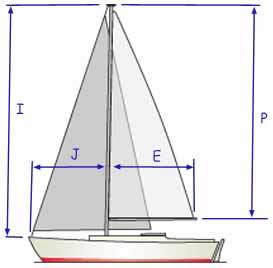 Sail Areas & Rig Dimensions
Sail Areas & Rig DimensionsSail Areas
- Mainsail Area: 331 ft² / 31 m²
- 100% Foretriangle Area: 466 ft² / 43 m²
- Total Sail Area: 797 ft² / 74 m²
Rig Dimensions
- I (foretriangle height): 53'2" / 16.22 m
- J (foretriangle base): 17'6" / 5.33 m
- P (main luff): 46'6" / 14.17
- E (main foot): 14'3" / 4.34 m
Published Design Ratios
The Key Performance Indicators (KPIs)
The key design ratios for the Catalina Morgan 43 are:
- Sail Area/Displacement (SA/D): 15.60
- Displacement/Length (D/L): 237.9
- Ballast/Displacement Ratio (B/D): 34.89
- Capsize Screening Formula (CSF): 1.89
- Motion Comfort Ratio (MCR): 30.15
Theoretical Sailing Characteristics
These design ratios offer insights into the Catalina Morgan 43's theoretical sailing performance:
Sail Area/Displacement Ratio (SA/D): 15.60
This ratio indicates the boat's power-to-weight. A ratio under 15 is generally considered under-canvassed, while values above 15 suggest reasonably good performance. A SA/D of 15.60 places the Catalina Morgan 43 right at the cusp of "reasonably good performance." This suggests it might perform adequately in light to moderate winds, but could struggle to maintain speed in very light air or when heavily loaded. It's not a high-performance racer, but rather a more balanced cruiser.
Ballast/Displacement Ratio (Bal./Displ.): 34.89
This ratio indicates the boat's initial stability and ability to resist heeling. A ratio of 40% or more typically signifies a stiffer, more powerful boat. The Catalina Morgan 43's ratio of 34.89% suggests it is moderately stiff. While it won't be as stiff as a boat with a higher ballast ratio, it should still be able to stand up to a reasonable amount of wind. It implies a more comfortable, less aggressive motion in a seaway compared to very stiff boats, but it might heel more readily in gusts.
Displacement/Length Ratio (Disp./Len.): 237.90
This ratio helps classify a boat's displacement relative to its waterline length.
- Light displacement: < 100
- Moderate displacement: 100 - 200
- Heavy displacement: 200 - 300
- Very heavy displacement: > 300
A D/L of 237.90 places the Catalina Morgan 43 firmly in the heavy displacement category. This suggests the boat will be:
- Comfortable in a seaway: Heavy displacement boats tend to have a more comfortable motion in waves, ploughing through them rather than bouncing over them.
- Less sensitive to overloading: The boat's performance will not be as significantly impacted by carrying extra crew, provisions, or gear.
- Slower in light air: Heavy displacement means more water to push aside, which can translate to slower speeds in light wind conditions.
- Good for cruising: This characteristic is often desired in cruising boats for their stability and capacity for stores.
Comfort Ratio: 30.15
Ted Brewer's Comfort Ratio is a subjective measure intended to indicate a boat's motion comfort in a seaway. Higher numbers generally suggest a more comfortable motion, particularly favouring heavy displacement, narrow-beamed vessels with long overhangs. A ratio of 30.15 indicates that the Catalina Morgan 43 should provide a relatively comfortable ride, especially for coastal cruising. It aligns with its heavy displacement nature, suggesting it's designed for a smooth motion rather than a lively one.
Capsize Screening Formula (CSF): 1.89
This formula is used to assess a sailboat's susceptibility to capsize in rough conditions. A lower number indicates greater resistance to capsize. For offshore sailing, a CSF of 2.0 or less is generally considered desirable. The Catalina Morgan 43's CSF of 1.89 places it within the range suitable for ocean passages. This suggests a good level of stability and offshore capability, making it a relatively safe choice for bluewater cruising.
In summary, the design ratios for the Catalina Morgan 43 suggest it is a robust and comfortable cruising sailboat. Its heavy displacement and good comfort ratio indicate a stable platform for extended voyages, particularly in varied sea states. While not a speed demon, its SA/D suggests adequate performance for a cruiser, and its low Capsize Screening Formula indicates good offshore safety. It's built for steady progress and crew comfort rather than pure speed or racing prowess.
But the Design Ratios Don't Tell the Whole Story...
While design ratios provide a useful theoretical framework for understanding a sailboat's general characteristics, they have several significant limitations:
1. Simplification of Complex Hydrodynamics: Sailboat performance is governed by incredibly complex interactions between the hull, keel, rudder, sails, and the fluid mediums (water and air). Design ratios reduce these intricate dynamics to simple mathematical relationships, which cannot fully capture the nuances of how a boat behaves in different conditions. For example, they don't account for:
- Hull Shape and Volume Distribution: Two boats with the same D/L ratio can have very different hull shapes. A boat with fine ends and a full midsection will behave differently in waves than a boat with plumb bows and wide transoms, even if their overall length and displacement are similar.
- Keel and Rudder Foils: The actual foil sections, aspect ratio, and planform of the keel and rudder significantly affect lift and drag, which isn't captured by simple ratios. A deep, high-aspect fin keel will provide more lift and less drag than a shallow, low-aspect one of the same ballast weight, influencing pointing ability and speed.
- Location of Ballast: The Ballast/Displacement Ratio only tells you the percentage of total displacement that is ballast. It doesn't tell you where that ballast is placed. Ballast at the very tip of a deep fin keel provides significantly more righting moment (and thus stiffness) than the same weight of internal ballast or ballast in a shallow keel, profoundly affecting how the boat stands up to wind.
2. Ignores Rigging and Sail Plan Details:
- Sail Plan Efficiency: The SA/D ratio uses total sail area, but doesn't differentiate between efficient sail plans (e.g., modern high-aspect ratio rigs) and less efficient ones. A well-designed, easily trimmed sail plan can make a boat with a lower SA/D sail faster than a boat with a higher SA/D but a poorly optimised rig.
- Mast Type and Stiffness: The type of mast (e.g., deck-stepped vs. keel-stepped), number of spreaders, and overall rig stiffness influence how efficiently the sails can be set and how much power can be generated or spilled.
- Sail Material and Shape: The actual shape and condition of the sails (e.g., Dacron vs. laminate, fresh vs. blown out) are crucial to performance, but entirely absent from these static ratios.
3. Does Not Account for External Factors:
- Sea State: Ratios don't predict how a boat will perform in specific wave conditions (e.g., short chop versus long swells). A heavy boat might feel comfortable in long swells but pound in short, steep waves.
- Wind Conditions: While SA/D gives an indication of performance in moderate air, it doesn't fully predict behaviour in very light or very heavy winds. A boat that is "under-canvassed" might be slow in light air but a dream to handle in a gale.
- Crew Skill and Trim: The most well-designed boat can perform poorly with an inexperienced crew or incorrect sail trim. Ratios are theoretical and assume optimal handling.
4. Subjectivity in Comfort and Safety Ratios:
- Comfort Ratio: Ted Brewer's Comfort Ratio is based on specific design philosophies (favouring traditional heavy, narrow boats). Modern, wider, lighter displacement cruisers might score poorly on this ratio but still be perfectly comfortable in a seaway due to different hull forms and stability characteristics.
- Capsize Screening Formula (CSF): While useful for a preliminary screening, the CSF is a simplified formula that primarily considers beam and displacement. It does not account for the boat's ultimate stability curve, which is a more accurate representation of its resistance to capsize at various angles of heel. It's a "screening" tool, not a definitive safety guarantee.
5. Doesn't Reflect Interior Volume or Liveability: Ratios focus on performance and motion but give no insight into how spacious, practical, or well-laid out the interior of a sailboat is, which is a significant factor for cruisers.
6. Static Measures: All these ratios are static calculations based on design parameters. They don't evolve with the boat's actual condition (e.g., added gear, fouled bottom, damaged sails) or the dynamic nature of sailing.
In conclusion, design ratios are valuable as initial comparative tools and for gaining a general theoretical understanding of a sailboat's intended purpose (e.g., heavy cruiser vs. light racer). However, they are highly simplified and should never be the sole basis for judging a sailboat's actual sailing characteristics, performance, or suitability for a specific use. A thorough assessment requires considering detailed design plans, performance data, sea trials, and owner reviews.
More Specs & Key Performance Indicators for Popular Cruising Boats
Recent Articles
-
Marine Cabin Heaters: The Expert’s Guide to Comfort & Safety at Sea
Dec 05, 25 06:52 AM
Choose the best Marine Cabin Heaters for your vessel. Expert advice on diesel, paraffin, and hot water systems for year-round cruising comfort. -
Marine Water Heating Systems: Free Hot Water from Your Boat's Engine
Dec 03, 25 05:06 PM
Tap into your engine's heat to get free hot water on board. An experienced ocean sailor's guide to marine water heating systems, calorifiers & safety. -
Marine Watermakers: An Offshore Sailor’s Guide & Practical Tips
Dec 03, 25 04:31 AM
Boost your yacht's range with Marine Watermakers. A Yachtmaster's guide to choosing, installing, and maintaining reverse osmosis desalinators for reliable, fresh water on long passages.
